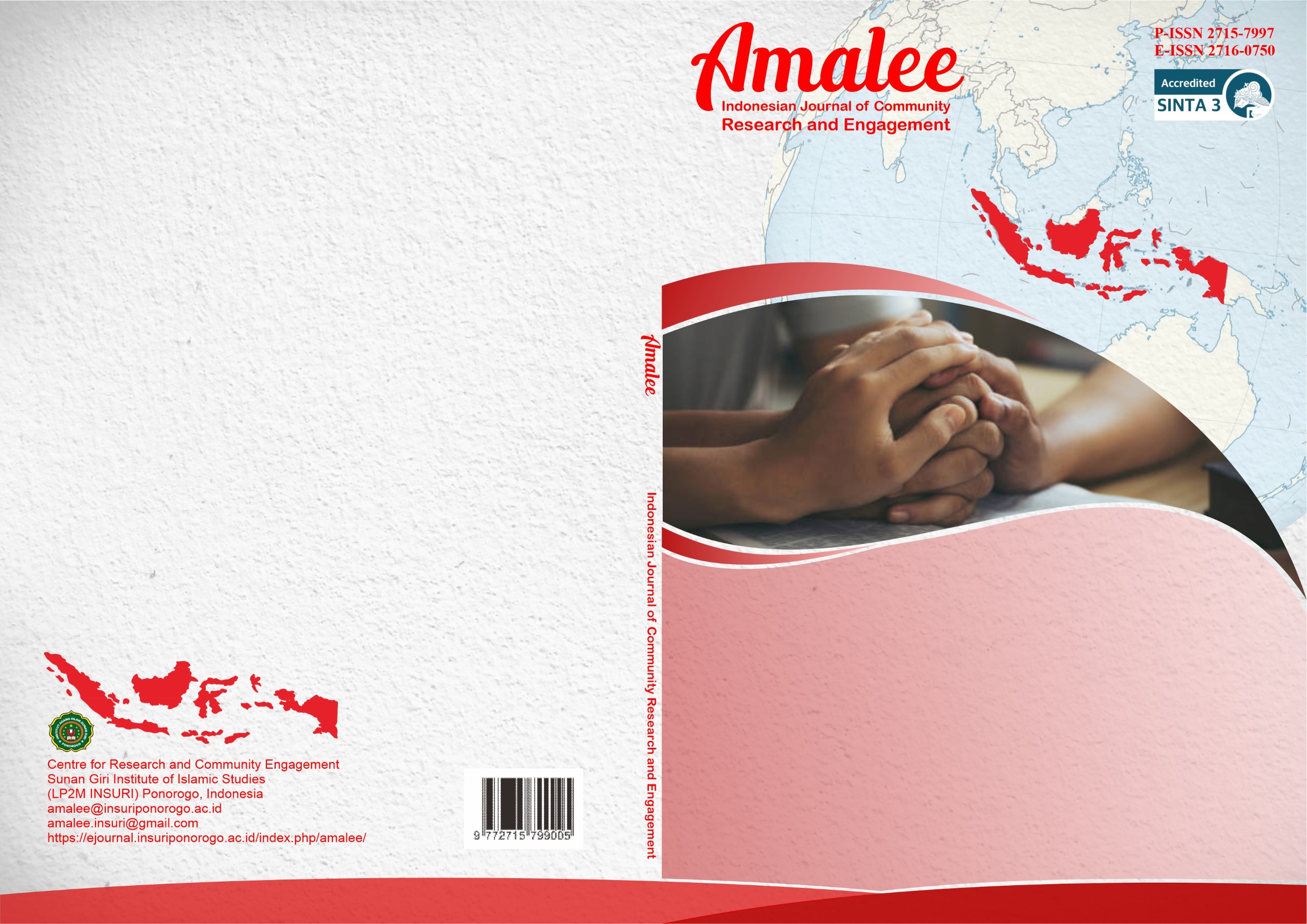Training on Tunnel Technology to Increase Salt Production in Jepara Regency
DOI:
https://doi.org/10.37680/amalee.v5i2.6019Keywords:
Jepara, Salt, Training, TunnelAbstract
Rainwater is one of the factors that can affect salt production in Jepara Regency. Salt tunnel technology can retain rainwater so that salt farmers can produce salt even during the rainy season. However, salt farmers have not yet fully utilized this technology. So that assistance is needed to them about the application of salt tunnel technology. This program is conducted to increase the knowledge and skills of salt farmers about salt tunnel technology. The community service partner is UKM Rumah Garam in Surodadi Village, Kedung District, Jepara Regency. The activity was carried out in August 2024. The flow of implementing activities includes preparation, provision of tools and materials, implementation of training, partner assistance and evaluation. The training was attended by partner members with training material on Sustainable Salt Production Technology. The next stage is the field practice of making salt tunnel construction in the salt field owned by one of the participants. The construction is made of bamboo and the soil is coated with geoisolator while the cover uses UV plastic. The community service activity was able to increase the knowledge and skills of the participants about salt tunnel technology which is expected to increase the amount of salt production.
References
Adiraga, Y., & Setiawan, A. H. (2014). Produksi Usaha Garam Rakyat Di Kecamatan Juwana Kabupaten Pati Periode 2003-2012. Diponegoro Journal Of Economics, 3(1), 1–13. https://doi.org/https://ejournal3.undip.ac.id/index.php/jme/article/view/5314
Amin, A. A. (2023). Greenhouse Salt Tunnel as Innovation to Create Salt Production in the South Coast Malang Regency, Indonesia. Jurnal Pembangunan Dan Alam Lestari, 14(1). https://doi.org/10.21776/ub.jpal.2023.014.01.03
Bawahab, M., Faqeha, H., Ve, Q. L., Faghih, A., Date, A., & Akbarzadah, A. (2019). Industrial heating application of a salinity gradient solar pond for salt production. Energy Procedia, 160(2018), 231–238. https://doi.org/10.1016/j.egypro.2019.02.141
Bhat, A. H., Sharma, K. C., & Banday, U. J. (2015). Impact of Climatic Variability on Salt Production in Sambhar Lake, a Ramsar Wetland of Rajasthan, India. Middle-East Journal of Scientific Research, 23(9), 2060–2065. https://doi.org/10.5829/idosi.mejsr.2015.23.09.95224
Chakrabarty, S. G., Wankhede, U. S., Shelke, R. S., & Gohil, T. B. (2020). Investigation of temperature development in salinity gradient solar pond using a transient model of heat transfer. Solar Energy, 202(February), 32–44. https://doi.org/10.1016/j.solener.2020.03.052
Diskan Kab Jepara. (2024). Data Produksi Garam Rakyat Tahun 2018-2022 Kabupaten Jepara, Dinas Perikanan Kabupaten Jepara.
Dwiyitno, D., Sturm, M. T., Januar, H. I., & Schuhen, K. (2021). Influence of various production methods on the microplastic contamination of sea salt produced in Java, Indonesia. Environmental Science and Pollution Research, 28(23), 30409–30413. https://doi.org/10.1007/s11356-021-14411-6
Febrizki, M. Y., & Luthfi, A. (2022). Resilensi Petani Garam Rakyat dalam Mempertahankan Usaha Ekonomi Di Desa Kedung Malang, Kecamatan Kedung, Kabupaten Jepara. Solidarity: Journal of Education, Society and Culture, 11(1), 12–26. https://doi.org/10.15294/solidarity.v11i1.58794
Guntur, G., Jaziri, A. A., Prihanto, A. A., Arisandi, D. M., & Kurniawan, A. (2018). Development of salt production technology using prism greenhouse method. IOP Conference Series: Earth and Environmental Science, 106(1), 1–7. https://doi.org/10.1088/1755-1315/106/1/012082
Joesidawati, M. I., & Suwarsih. (2019). Pelatihan Produksi Garam Rakyat Dengan Metode Tunnel Bersirip. Jurnal Abdi Mas TPB, 1.
Liu, B., Wang, S., Liu, X., & Sun, H. (2022). Evaluating soil water and salt transport in response to varied rainfall events and hydrological years under brackish water irrigation in the North China Plain. Geoderma, 422(April), 115954. https://doi.org/10.1016/j.geoderma.2022.115954
Mahasin, M. Z., Rochwulaningsih, Y., & Sulistiyono, S. T. (2020). Coastal Ecosystem as Salt Production Centre in Indonesia. E3S Web of Conferences, 202. https://doi.org/10.1051/e3sconf/202020207042
Mustofa, A. (2016). Strategi Pengembangan Usaha Garam Rakyat di Kecamatan Kedung Kabupaten Jepara. Jurnal DISPROTEK, 7(2), 22–29. https://ejournal.unisnu.ac.id/JDPT/article/view/423
Mustofa, A., & Wijanarko, K. D. (2022). Pengenalan Metode Penyimpanan dan Pengemasan Ikan Asap Di Desa Dermolo Kecamatan Kembang Kabupaten Jepara. Seminar Nasional Pengabdian Kepada Masyarakat, 16–17.
Nurdiani, R., Jaziria, A. A., Jatmiko, Y. D., Muyasyaroh, H., Pratama, N. A., Kholil, M. I., & Maulidia, M. A. (2020). Pengabdian Kepada Masyarakat Melalui Pengenalan Kemasan Vakum Untuk Ikan Asap Khas Tuban. Prosiding Seminar Nasional Perikanan Dan Kelautan VIII ISBN : 978-602-72784-3-1, 170–174.
Nuzula, N. I., Masruroh, I., Kartika, A. G. D., Efendy, M., & Setiyawan, F. (2023). Evaporation Rate Analysis Of Raw Water In Salt Production Using a Prototype At Salt House. IOP Conference Series: Earth and Environmental Science, 1250(1), 1–11. https://doi.org/10.1088/1755-1315/1250/1/012004
Parsa, S. M., Majidniya, M., Alawee, W. H., Dhahad, H. A., Ali, H. M., Afrand, M., & Amidpour, M. (2021). Thermodynamic, economic, and sensitivity analysis of salt gradient solar pond (SGSP) integrated with a low-temperature multi effect desalination (MED): Case study, Iran. Sustainable Energy Technologies and Assessments, 47(December 2020), 101478. https://doi.org/10.1016/j.seta.2021.101478
Petereit, J., Saynisch, J., Irrgang, C., Weber, T., & Thomas, M. (2018). Electromagnetic characteristics of ENSO. Ocean Science, 14(3), 515–524. https://doi.org/10.5194/os-14-515-2018
Prabawa, F. Y., & Bramawanto, R. (2021). The intensification of industrial salt production using the salt production house concept. IOP Conference Series: Earth and Environmental Science, 925(1). https://doi.org/10.1088/1755-1315/925/1/012031
Prajapati, S., Mehta, N., & Yadav, S. (2021). An overview of factors affecting salt gradient solar ponds. Materials Today: Proceedings, xxxx. https://doi.org/10.1016/j.matpr.2021.09.538
Rghif, Y., Zeghmati, B., & Bahraoui, F. (2019). Modeling of a salt gradient solar pond under Moroccan climate taking into account double-diffusive convection. Materials Today: Proceedings, 30, 883–888. https://doi.org/10.1016/j.matpr.2020.04.345
Saiful, Firdus, & Suhendrayatna. (2019). Peningkatan Kuantitas Dan Kualitas Garam Rakyat Dengan Terapan Teknologi Geomembran Dan Tunnel. Prosiding Seminar Nasional Ke-IV Fakultas Pertanian Universitas Samudra.
Tansuchat, R. (2023). A Copula-Based Meta-Stochastic Frontier Analysis for Comparing Traditional and HDPE Geomembranes Technology in Sea Salt Farming among Farmers in Phetchaburi, Thailand. Agriculture (Switzerland), 13(4). https://doi.org/10.3390/agriculture13040802
Downloads
Published
How to Cite
Issue
Section
License
Authors who submit manuscript retain its copyright and grant Amalee right of first publication licensed under a Creative Commons Attribution-ShareAlike 4.0 International License (CC BY-SA 4.0) that allows others to access (search, read, download, and cite), share (copy and redistribute the material in any medium or format) and adapt (remix, transform, and build upon any material) the work for any lawful purpose, even commercially with an acknowledgement of the work's authorship and initial publication in Amalee: Indonesian Journal of Community Research and Engagement.














